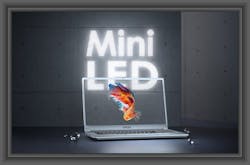Taiwan-based MSI has announced commercial availability of the Creator 17 notebook/laptop PC that is the first such PC to utilize a mini-LED-based display. The PC has arguably the highest-quality display on the market with the mini LED backlights delivering better screen brightness and more granular dimming zones, besting even OLED screens. The Creator 17 is the first notebook to meet DisplayHDR 1000 standards.
We visited the CES (formerly known as the Consumer Electronics Show) event in January to gauge the maturity of mini and micro LED technologies that will first materialize in display applications and published a feature article on the technology. We saw products from smart watches to video walls using mini or micro LED technology, but little was commercially available beyond very-high-end desktop computer monitors. The Creator 17 may mark the first evidence of mini LEDs establishing a mainstream commercial presence.
The new MSI system features 4k resolution in the 17-in screen. DisplayHDR 1000 is one in a series of VESA performance standards related to what is being called high dynamic range (HDR) video. The 1000 level refers to a combination of color gamut and luminance or brightness specifications. The new PC’s display outputs 1000 nits — a nit is a measure of luminance delivered within a given screen area characterized by cd/m2. The display features 240 local dimming zones, which essentially improves contrast ratio and dynamic range.
MSI is targeting the Creator 17 at professionals and artists working in content creation. The notebook is priced just under $2000. For now, gamers will primarily be served with models that stress graphic acceleration over absolute screen quality. MSI also said that at this time coronavirus is having no impact on its Taiwan manufacturing operation.
As we wrote in our CES feature, and in an article last year on directly emissive LED displays, mini and micro LEDs will serve in the short and near term in display applications. Mini LEDs will primarily be used to improve the quality in backlit LCD screens. MSI said the approach delivers lower power usage in addition to higher-quality images. Micro LEDs will allow the industry to transition to self-emissive display technologies in PCs, TVs, and more.
Mini and micro LEDs share the roadblock of needed techniques for transferring massive numbers of nano-scale LEDs from wafers to an application substrate of some type. The micro LED simply escalates the magnitude of that problem.
Apple has been among the most committed of investors into the technologies. Indeed, many industry watchers had expected mini-LED-based products from Apple by now. And such products could still emerge this year. The company has been rumored to be working on both iPad and MacBook models using mini LED backlights and industry watchers were largely disappointed when the latest Apple Watch emerged based on legacy technology.
The question of course for the broader LED and solid-state lighting (SSL) sectors is how mini and micro technology fit into the equation. The display applications are going to consume an incredible amount of LED epitaxial real estate. But it’s unclear how existing LED manufacturers fit into that picture with new companies, especially in Taiwan, looking for a spot in the supply chain. Longer term, however, micro LEDs have the potential of changing the game completely in how general illumination is delivered. Bob Karlicek of the Center for Lighting Enabled Systems & Applications (LESA) lab at Rensselaer Polytechnic Institute made just that point in his Strategies in Light Keynote address this past February.





